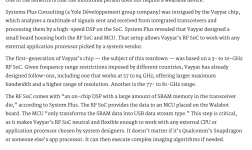FYI - about 2% royalties. Say $15 chip x 2% = 30 cents.
ARM sold 29.2B chips in 2021. If BRN can find it's way into 5% of ARM chips = 1.5B chips x 30c = $450M revenue. If royalties are 1% then revenue will be $225M.
ARM IP revenue model
The upfront license fee depends on the complexity of the design you’re licensing. An older ARM11 will have a lower up front fee than a Cortex A57. The upfront fee generally ranges from $1M - $10M, although there are options lower or higher than that (I’ll get to that shortly).
The royalty is on a per chip basis. Every chip that contains ARM IP has a royalty associated with it. The royalty is typically 1 - 2% of the selling price of the chip. For chips that are sold externally that’s an easy figure to calculate, but if a company is building and selling a chip internally the royalty is based on what the market price would be for that chip.
Both the up front license fee and the royalty are negotiable. There are discounts for multiple ARM cores used in a single design. This is where things like support contracts come into play.
Buses/interfaces come for free, you really just pay for CPU/GPU licenses. ARM’s Mali GPU is typically going to be viewed as an adder and is currently viewed as demanding less of a royalty than ARM’s high-end CPU licenses. A rough breakdown is below:
ARM Example Royalties | |
| IP | Royalty (% of chip cost) |
| ARM7/9/11 | 1.0% - 1.5% |
| ARM Cortex A-series | 1.5% - 2.0% |
| ARMv8 Based Cortex A-series | 2.0% and above |
| Mali GPU | 0.75% - 1.25% adder |
| Physical IP Package (POP) | 0.5% adder |
In cases of a POP license, the royalty is actually paid by the foundry and not the customer. The royalty is calculated per wafer and it works out to roughly a 0.5% adder per chip sold.
It usually takes around 6 months to negotiate a contract with an ARM licensee. From license acquisition to first revenue shipments can often take around 3 - 4 years. Designs can then ship for up to 20 years depending on the market segment.
Of the 320 companies that license IP from ARM, over half are currently paying a royalty - the rest are currently in period between signing a license and shipping a product. ARM signs roughly 30 - 40 new licensees per year.
About 80% of the companies that sign a license end up building a chip that they can sell in the market. The remaining 20% either get acquired or fail for other reasons. Royalties make up roughly 50% of ARM’s total revenues, licensing fees are just over 33% and the remainder is equally distributed between software tools and technical support.
ARM's revenues are decent (and growing), but it's still a relatively small company. In 2012 ARM brought in $913.1M. Given how many ARM designs exist in the market (and the size of some of ARM's biggest customers), it almost seems like ARM should be raising its royalty rates a bit. Because of ARM's unique business model, gross margin can be north of 94%. Operating margin tends to be around 45% though.
Seeking answers? Join the AnandTech community: where nearly half-a-million members share solutions and discuss the latest tech.

www.anandtech.com
SoftBank Group Corp's chip technology firm Arm Ltd on Thursday reported record revenue for 2021, and Chief Executive Rene Haas told Reuters its business for new chip designs indicates a strong outlook.

www.reuters.com



 fortune.com
fortune.com





